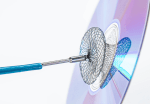In stent restenosis (ISR) continues to be the main limitation to the percutaneous treatment of coronary artery disease, with 5 to 10% prevalence after new generation DES stenting. Guideline recommendations for this intervention include new DES stenting and the use of drug coated balloons (DCB). Recurrent ISR stenting rate ranges between 10 and 40%, and...
Sub-Analysis of the REVIVED-BCIS2: Myocardial Viability Changes Prognosis in Ischemic Cardiomyopathy Revascularization?
The purpose of myocardial viability testing is to identify patients that might benefit from revascularization by diagnosing three types of myocardium: normal, viable or hibernating, and scarred (non-viable). Non-randomized studies have shown recovery of a viable ventricle after myocardial revascularization surgery (CABG) and improved survival. However, a sub-analysis of the main study on viability testing,...
Left Atrial Appendage Closure and Concomitant Transcatheter Intervention: Can We?
Several scientific societies support performing left atrial appendage occlusion (LAAO) as a stand-alone procedure, even though it is often associated to other cardiomyopathies requiring transcatheter intervention. Though still controversial, combining LAAO and any other cardiac intervention might reduce hospitalizations, as well as the need for additional punctures, anesthesia, red tape, a longer stay and higher...
Events According to Revascularization Modality in the ISCHEMIA Trial
The main studies carried out on patients with chronic coronary syndromes (CCS), such as the MASS II, COURAGE, BARI 2D and FAME-2, failed to show benefits in terms of mortality with the invasive approach. The ISCHEMIA, a large randomized study including patients with moderate to severe ischemia, with without left main disease and with acceptable...
MYVAL, a TAVR Balloon-Expandable Valve with Promising Results
TAVR has been shown beneficial over time, and with the development of new generation of prosthetic valves and implantation techniques, outcomes have been improved, reducing the incidence of leaks y and the need for definite pacemaker. This study looked at the evolution of 100 patients with symptomatic aortic stenosis treated with Myval THV from Meril...
CAPTIS, a Novel Cerebral Embolic Protection System in TAVR
The incidence of stroke after TAVR ranges between 2 and 5%, depending on the series, which has been associated with higher morbimortality, affecting patient quality of life and their psycho-social environment. Many cerebral embolic protection systems have been developed in response, and even though they have been shown beneficial in many studies, their role in...
Long-Term Results from the BEST Study: Drug-Eluting Stents vs. Bypass Surgery in Diabetic Patients with Multiple Vessel Disease
The impact of diabetes on the development of cardiovascular disease is widely known, with a strong association with extensive and diffuse coronary artery disease. Decision-making regarding how to revascularize patients with multi-vessel disease is a complex process. In this context, coronary artery bypass grafting (CABG) has been recommended over percutaneous coronary intervention (PCI) based on...
Ultrathin Stents Shown Safe and Effective in Real World Patients
Ultrathin drug eluting stents (60 µm) had been shown beneficial vs. thin-strut stents in terms of target lesion failure (TLF) at 2, 3 and 5 years in randomized studies, but they had not been yet assessed in “real world” patients. The BIOFLOW VII is a prospective, multicenter study including 556 “real world”patients with a total...
Complex Coronary Angioplasty in Elderly Patients: Problem or Solution?
Cardiovascular disease is the leading cause of death in elderly adults (individuals aged 75 years or older). In turn, coronary heart disease is one of the main causes of morbidity in this population. In addition to anatomical complexities, there are other factors that may complicate its management, such as polypharmacy, frailty, and procedure-related risks. All of...
Should We Use Ultrasound to Guide Transfemoral Access Routinely?
Currently, transfemoral access (TFA) is used in large-caliber procedures and when transradial access is not successful. The use of ultrasound (US) to guide access has emerged as a technique that allows for precise cannulation, avoiding accesses above and below the inguinal ligament. However, evidence regarding the effectiveness of this tool has shown variable results. Two...









